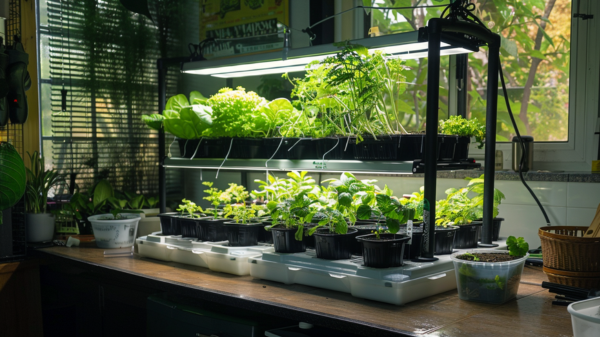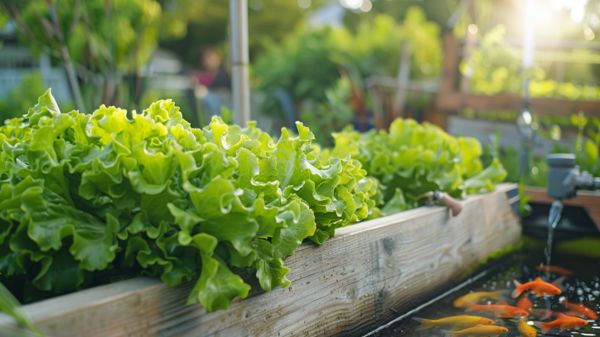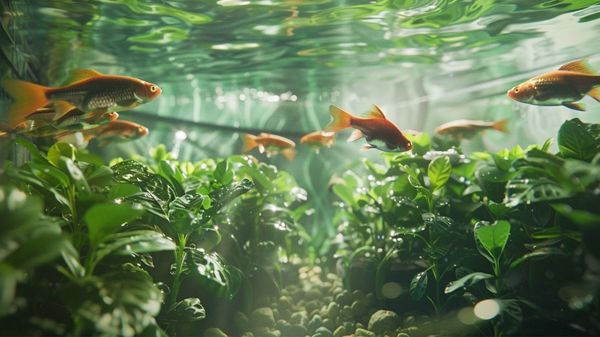Aquaponics presents a compelling approach to sustainable agriculture, particularly for beginners looking to integrate fish and plant cultivation. Today’s post will be discussing several ideas of aquaponics system design especially for beginners.
Among the numerous designs available, seven stand out for their accessibility and effectiveness: Media Bed, Nutrient Film Technique (NFT), Deep Water Culture (DWC), Vertical Systems, Dutch Buckets, Wicking Beds, and Hybrid Systems. Each of these systems offers distinct advantages that cater to various environmental conditions and user preferences.
Understanding the features of these systems is essential, especially for those keen to set out on their aquaponics journey. What considerations should one keep in mind when selecting the ideal system?
Key Takeaways
- Media Bed Aquaponics is beginner-friendly, utilizing gravel for plant support and excellent biological filtration from beneficial bacteria.
- Nutrient Film Technique (NFT) maximizes space efficiency, ideal for urban settings, but requires careful monitoring for optimal plant growth.
- Deep Water Culture (DWC) accelerates growth with floating rafts, ensuring continuous nutrient and oxygen access for healthy plants.
- Vertical Aquaponics systems optimize limited space, increasing sunlight exposure for enhanced yields while requiring structural stability.
- Dutch Buckets utilize drip irrigation for efficient nutrient delivery, suitable for larger plants like tomatoes and cucumbers, promoting sustainability.
Media Bed Aquaponics System
The Media Bed Aquaponics System, often referred to as the Flood and Drain system, is an accessible and effective choice for those new to aquaponics. This innovative system employs a grow bed filled with materials like gravel, clay pebbles, or lava rock, providing the essential structure for plant roots while simultaneously filtering water.
The operation is straightforward: nutrient-rich water from the fish tank periodically floods the grow bed and then drains back, guaranteeing that plants receive both the nutrients and oxygen they require. This system is scalable, allowing beginners to start small and expand as they gain more experience and confidence in managing their aquaponic garden.
A key advantage of the media bed aquaponics system is its excellent biological filtration capabilities. The solid media fosters beneficial bacteria that convert fish waste into plant-accessible nutrients, creating a thriving ecosystem.
While this system can support a variety of crops, including fruits and vegetables, its design may limit overall growing space, potentially leading to lower yields compared to more advanced systems.
For beginner gardeners, the maintenance of media beds involves regular cleaning to prevent clogging and constant monitoring to guarantee superior water levels and nutrient availability.
This hands-on approach empowers new growers to engage deeply with their aquaponic systems, fostering a fulfilling journey towards sustainable gardening.
Nutrient Film Technique (NFT)
The Nutrient Film Technique (NFT) aquaponics system is characterized by a continuous flow of nutrient-rich water over plant roots, effectively delivering essential nutrients and oxygen while promoting efficient growth.
Its water-efficient design makes it particularly suitable for urban gardening and small-scale operations, especially for fast-growing, low-stature crops like leafy greens.
However, successful implementation requires careful setup and maintenance, including regular monitoring of system components and the integration of a biofilter for ideal nutrient conversion.
System Overview and Benefits
While exploring sustainable agricultural practices, one will find that the Nutrient Film Technique (NFT) aquaponics system stands out for its innovative approach to combining hydroponics and aquaculture.
This method utilizes a thin film of nutrient-rich water that continuously flows over plant roots, delivering essential nutrients and oxygen for peak growth.
The benefits of the NFT system include:
- Water Efficiency: NFT is highly water-efficient, utilizing far less water than traditional farming methods, making it ideal for urban and small-scale gardens.
- Space Efficiency: The design of NFT systems allows for maximum production in limited areas, which is particularly advantageous for commercial use.
- Ideal for Leafy Greens: Fast-growing leafy greens such as lettuce and kale thrive in the shallow water film, making NFT suitable for those crops.
- Maintenance: Regular maintenance is critical, as effective solid filtration is necessary to prevent clogging and maintain consistent water flow to the plants.
Incorporating NFT into your aquaponics strategy not only promotes sustainable practices but also enhances the efficiency of food production systems, fostering a liberating journey towards self-sufficiency.
Setup and Maintenance Tips
Successful implementation of an NFT aquaponics system requires careful attention to both setup and ongoing maintenance. The Nutrient Film Technique (NFT) relies on a thin film of nutrient-rich water flowing over the roots of plants, enhancing oxygen and nutrient absorption while minimizing water usage.
To guarantee success, regular monitoring of water quality is essential. In NFT systems, a separate biofilter is necessary to convert fish waste into usable nutrients, as the reduced surface area for beneficial bacteria demands diligent oversight.
Maintaining a consistent water flow rate is vital; this prevents roots from drying out while avoiding stagnation, which can lead to root rot. For peak functionality, consider implementing a timer for the water pump. This automation guarantees that the nutrient film is delivered at regular intervals, supporting healthy plant growth.
Additionally, it is important to remember that NFT systems are best suited for growing leafy greens and herbs. These plants thrive in the shallow water film provided by the NFT setup, making them ideal for maximizing space and resources.
Ideal Crop Selection
Which crops are best suited for the Nutrient Film Technique (NFT) system? The NFT system is particularly effective for growing fast-growing, leafy greens that thrive in a shallow stream of nutrient-rich water.
This hydroponic approach enhances conditions for crops with minimal root systems, ensuring ideal growth and nutrient uptake. Here are four crops that excel in NFT systems:
- Lettuce – A staple in hydroponics, it reaches harvest maturity in as little as 30 days.
- Spinach – Thrives in nutrient-rich water and offers quick growth under favorable conditions.
- Basil – An aromatic herb that benefits from the consistent nutrient flow, promoting robust flavor.
- Kale – A nutrient-dense leafy green that flourishes in NFT setups with proper pH levels and water quality.
Selecting the right crops is vital for successful NFT cultivation. Since larger fruiting plants like tomatoes or cucumbers require extensive nutrient access, they are not recommended.
Regular monitoring of pH levels and water quality is essential for maintaining healthy plants and achieving ideal growth rates in your aquaponics system.
Deep Water Culture (DWC)
Deep Water Culture (DWC) systems represent an innovative approach in aquaponics, utilizing floating rafts to suspend plant roots in a nutrient-rich solution, which greatly accelerates growth rates for leafy greens and herbs.
The effectiveness of DWC relies on essential components such as aeration devices and careful management of water quality parameters, which are vital for maintaining a balanced ecosystem.
Understanding the system’s overview, benefits, and best practices for maintenance will empower beginners to optimize their DWC setup for maximum productivity.
System Overview and Benefits
In the domain of aquaponics, the Deep Water Culture (DWC) system stands out as a remarkably efficient method for cultivating plants. This innovative approach suspends plants on floating rafts, allowing their roots to thrive in nutrient-rich water, which accelerates plant growth.
DWC is particularly advantageous for commercial production, as it maximizes space utilization and supports high-density planting, making it ideal for crops like lettuce and herbs.
The benefits of DWC systems include:
- Rapid Plant Growth: Continuous access to nutrient-rich water and oxygen fosters faster growth rates than many traditional methods.
- Space Efficiency: High-density planting means more crops can be cultivated in less area, making it suitable for urban settings.
- Stable Nutrient Supply: The system guarantees a consistent flow of nutrients and oxygen, crucial for healthy root development.
- Water Quality Management: Regular monitoring of water quality parameters such as pH and dissolved oxygen is imperative, preventing issues like root rot and nutrient deficiencies.
Essential Components Needed
To successfully set up a Deep Water Culture (DWC) system, you must gather several vital components and configure them properly. The foundation of a DWC system is the fish tank, which houses the aquatic life and provides nutrient-rich water important for plant growth.
A floating raft or platform, often made from styrofoam, supports the plants while allowing their roots to dangle into the solution, maximizing nutrient uptake and promoting robust growth.
Aeration is essential in DWC systems; an air pump connected to air stones or diffusers guarantees proper oxygenation of the water, preventing root rot and fostering ideal plant health. Additionally, a water pump is necessary to circulate the nutrient-rich water, making sure that all plant roots remain submerged and receive adequate nutrients.
Regular monitoring of water quality parameters, including pH levels (ideally between 5.5 and 7) and dissolved oxygen levels (at least 5 mg/L), is critical for maintaining a harmonious ecosystem.
The simplicity of the DWC design makes it particularly suitable for beginners, as it allows for easier access to plants for maintenance and harvesting while providing a productive environment for both fish and plants.
Best Practices for Maintenance
Maintaining a healthy Deep Water Culture (DWC) system requires a systematic approach to guarantee both fish and plants thrive in a balanced ecosystem. Key practices guarantee ideal water quality and nutrient delivery, essential for the health of aquatic life and vegetation.
- Monitor Water Quality: Regularly check pH levels, ammonia, nitrite, and nitrate concentrations, targeting pH levels between 6.8 and 7.4 to maintain a conducive environment.
- Guarantee Aeration: Use air stones or pumps to deliver adequate oxygen to submerged roots, preventing hypoxic conditions that lead to root rot.
- Conduct Routine Checks: Regular maintenance of the water pump and filtration system is essential to prevent clogging and guarantee continuous water flow, which is vital for nutrient delivery and overall system health.
- Maintain Ideal Water Temperature: Keep water temperature between 68°F and 75°F to promote fish health and plant growth, utilizing heaters or cooling systems as necessary.
Vertical Aquaponics System
A vertical aquaponics system represents an innovative solution for maximizing limited gardening space, particularly in urban environments where traditional gardening may be impractical.
In these systems, you grow the plants in vertical arrangements, allowing for efficient use of space while enhancing aesthetic appeal. Utilizing the Nutrient Film Technique (NFT), a thin film of nutrient-rich water is delivered directly to the roots, promoting ideal oxygenation and facilitating rapid growth.
One of the key benefits of vertical aquaponics is its ability to increase sunlight exposure, thereby accelerating growth rates and yields. However, careful design is essential to guarantee structural stability, as the combined weight of growing media and plants exerts significant pressure on the framework.
Regular maintenance is vital to prevent clogging in the delivery system and to monitor water quality, assuring a balanced ecosystem for both fish and plants. This approach not only maximizes the use of vertical space but also contributes to cost efficiency by reducing the need for additional fertilizers and enhancing water conservation.
Dutch Buckets
Dutch Buckets, familiar as the “bucket system,” are an effective aquaponics solution tailored for cultivating larger fruiting plants. This innovative system employs a drip irrigation method, ensuring that water and nutrients are delivered directly to the roots, thereby enhancing plant growth and productivity.
For those interested in sustainable home gardening, Dutch Buckets provide an excellent balance between efficiency and environmental friendliness.
The key components of Dutch Buckets include:
- Growing Medium: Buckets are filled with materials like lava rock or Hydroton, providing essential support, aeration, and drainage for the plants.
- Nutrient Cycle: Excess water drains from each bucket back to the fish tank, creating a continuous nutrient cycle that benefits both the plants and fish.
- Efficient Resource Management: This design minimizes water usage, making it an environmentally friendly choice for aquaponics enthusiasts.
- Space for Growth: Ideal for crops such as tomatoes, cucumbers, and peppers, Dutch Buckets accommodate plants that require more space and support compared to leafy greens.
Incorporating Dutch Buckets into an aquaponics system promotes sustainable practices, allowing beginners and experienced growers alike to maximize their yield while maintaining efficient water management.
Wicking Beds
Wicking beds are increasingly becoming familiar as an efficient method for growing a variety of plants while conserving water resources. Utilizing a sub-irrigation technique, these systems maintain consistent moisture levels from below, enabling plants to absorb water as needed. This not only minimizes evaporation but also promotes sustainable gardening practices.
Particularly beneficial for root crops such as potatoes, carrots, and radishes, wicking beds facilitate deep root growth, allowing easy access to moisture and nutrients. A carefully placed weed barrier prevents unwanted growth while moisture rises through capillary action, creating an ideal growing environment.
The integration of wicking materials, like composting soil, enhances nutrient delivery, making these systems suitable for both beginner gardeners and seasoned horticulturists. The efficiency of wicking beds reduces the frequency of watering required, promoting responsible water conservation.
| Feature | Benefits | Ideal For |
|---|---|---|
| Sub-Irrigation | Consistent moisture levels | Root crops |
| Capillary Action | Efficient nutrient uptake | Beginner gardeners |
| Water Conservation | Reduced evaporation | Sustainable gardening |
| Minimal Weeding | Clean growing environment | All plant types |
Incorporating wicking beds into your gardening repertoire can empower you to garden sustainably while enjoying the fruits of your labor.
Hybrid Aquaponics Systems
Embracing the versatility of hybrid aquaponics systems can greatly enhance the efficiency and productivity of your gardening efforts.
These systems integrate various techniques, such as media-based, NFT, and raft systems, optimizing resource use while improving nutrient delivery and oxygenation levels. They leverage the symbiotic relationship between fish and plants, where the fish provide essential nutrients to the plants, and in return, the plants help purify the water for fish, creating a continuous cycle of benefits.
Key benefits of hybrid aquaponics systems include:
- Flexibility: Adapt to different environmental conditions, making them suitable for a wide range of settings.
- Customization: Tailor setups based on budget, available space, and specific crop types, allowing for personalized gardening experiences.
- Vertical Growing Space: Maximize limited areas by incorporating vertical structures, thereby promoting effective light exposure and increasing overall yield.
- Diverse Crop Cultivation: Support a broader variety of fish and plant species, catering to both beginners and experienced growers.
Conclusion
To summarize, the diverse range of aquaponics system design for beginners offers valuable opportunities for beginners to engage in sustainable agriculture. Each system, from Media Beds to Hybrid configurations, presents unique advantages that cater to different cultivation needs and space constraints.
By selecting an appropriate design, individuals can foster a symbiotic relationship between aquatic and terrestrial life, ultimately contributing to efficient resource use and enhanced crop productivity. Embracing these systems promotes environmentally friendly practices and supports the development of resilient food systems.




